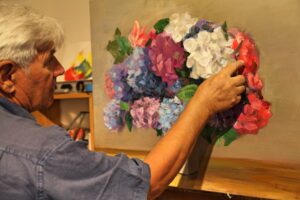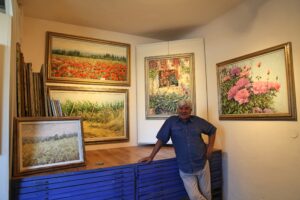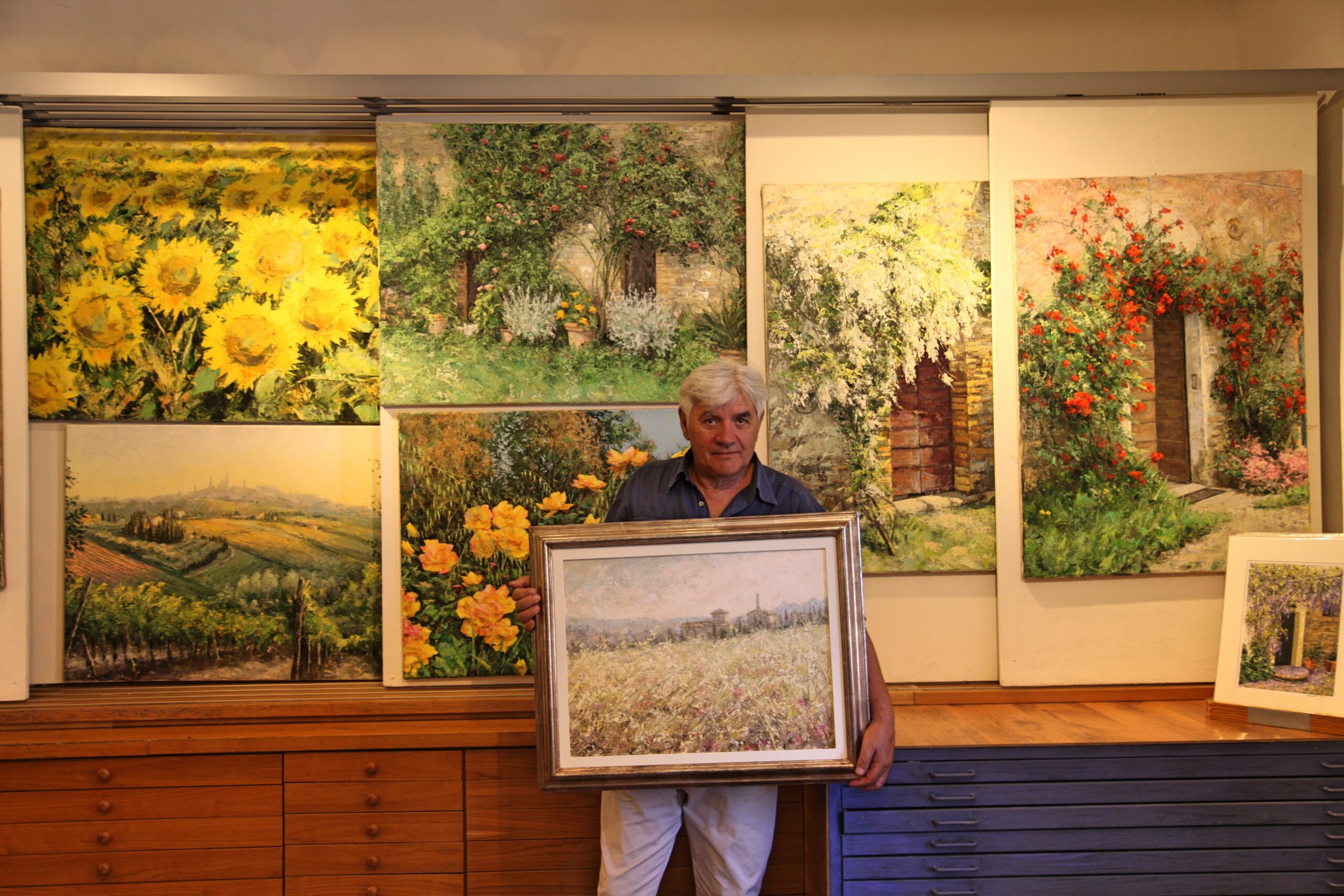I met Gordon Breckenridge a couple of years ago, in the Val d’Orcia, at a restaurant. Just by chance, on a day out of time, in the cool shade of a Wisteria, tasting Tuscan specialities. Even then I was struck by his generous sociability and his desire to communicate, typical of an artist who is also a ‘thinker’, a philosopher in his own way: “Come and visit me in San Gimignano in my studio when you can,” he said. I didn’t want to break the promise made that day, already sensing then how it hadn’t been an accidental meeting.
I like to look at the life of Gordon Breckenridge and his artistic epiphanies through the tender, albeit severe, memory of a young artist, an apprentice in the famous Florentine studio of Nera Simi in Via Tripoli: “We are all children of a mother – the Signorina (Nera Simi, ed.) was my second mother, my artistic godmother. I would never have been able to develop my skills without her teaching: she is part of who I am today. That was the essence, providing what I needed to continue my artistic journey throughout my life. She was a pure woman: respect for her values and morality were like foundations on which to build.”
 Like ‘poppy for the soul’ as Nietzsche put it, these words by Gordon who – as an artist and a man expert in life with all its deceptions – lets himself go in an unconditional declaration of love for the one who has unquestionably been his mistress in art and in life. In the age of auto-didacticism par excellence, digitized and moronic, this homage of humility, study and sacrifice comes like a fresh and fragrant glass of wine on a barren August evening.
Like ‘poppy for the soul’ as Nietzsche put it, these words by Gordon who – as an artist and a man expert in life with all its deceptions – lets himself go in an unconditional declaration of love for the one who has unquestionably been his mistress in art and in life. In the age of auto-didacticism par excellence, digitized and moronic, this homage of humility, study and sacrifice comes like a fresh and fragrant glass of wine on a barren August evening.
Gordon particularly recalls a fundamental anecdote: while he was working with other students on drawing a foot, after having deliberately ignored it for a while, Simi approached him and said: “This is the best you can do with your eyes.” A hermetic, enigmatic dart that tormented him for a long time without his reaching an adequate understanding: “For months I meditated on the meaning of the lesson I got that day. The Signorina explained to me that there are scales in art just as in music: you learn to recognize them when you go from representing only what you see, to drawing that allows what you cannot see but know is there to emerge.”
The whole secret of the Simi method was to avoid concentrating on detail and to work with large planes. Gordon has advanced this youthful genesis in his aesthetic: his is a kind of intuitive painting, particularly ‘philosophical’ and systemic – which has learned to proceed from the universal to the particular in an inductive way: the higher way of the spirit, the Idea that anticipates forms and represents their primordial origin.
 Without forgetting a fundamental notion! Where two planes with gradated tones meet, there is a point along their line of intersection where perception of that line disappears as the tonal values of the planes mingle because they are the same. This forms what is called ‘a passage of light’.
Without forgetting a fundamental notion! Where two planes with gradated tones meet, there is a point along their line of intersection where perception of that line disappears as the tonal values of the planes mingle because they are the same. This forms what is called ‘a passage of light’.
“When the values of these planes are correctly laid out, Gordon explains, there is no need to evoke passages of light since they automatically line up in the correct position. If a painting is made on the solid foundations of tonal value corrected on large planes, ‘the best you can do with your eyes’ emerges naturally.”
Once he had left Studio Simi, the Canadian-born artist began to paint landscapes en plein air on the hills of Florence. One day he showed one of his works to the Signorina who, without thinking twice, made a comment on the sky. “It’s just a big blue mark!” Thus she transmitted another fundamental technical and aesthetic canon, that is the basic principle in landscape painting: if the sky isn’t right, if it is only a symbol, nothing in the rest of the painting can work.
In all paintings, a single incorrect value places the overall synchrony in danger; in landscapes the power of the sky is absolute.
Gordon’s memories become so pure: “After taking control and mastery of these values with Nera Simi’s teaching, you feel like a boy who has just learned to dance and can now do it with his partner: the canvas. I learned not to paint, but to draw – my hand draws with colour.”
Today’s Gordon, after forty years spent painting en plein air, has not forgotten that distant memory, wanting to capture the ‘ontological’ essence of the light and colours of Tuscany: “So I went from knowledge to the search for light and colour even outside nature, giving people the opportunity to perceive the true light of Tuscany. What I paint is light, not form, he concludes.
To visit Gordon Breckenridge’s atelier and see his work, by appointment only: Piazzale Martiri di Montemaggio 1, San Gimignano (Si)/ Tel. 333 8611635 / gordonbreckenridge08@gmail.com / www.artgalleryintuscany.com
